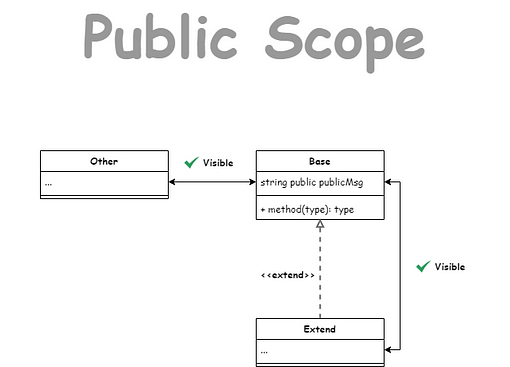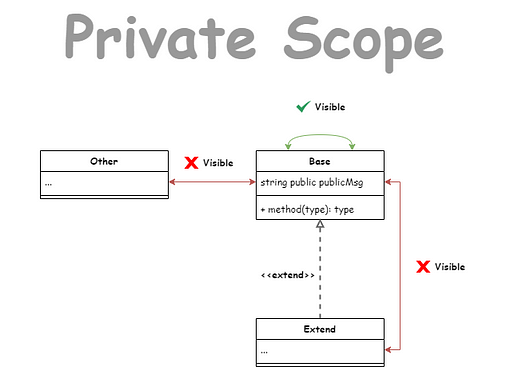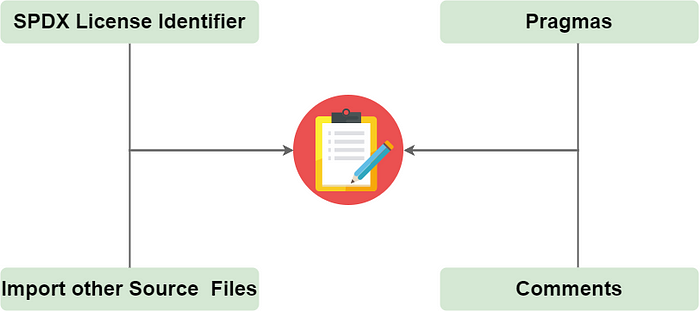
為什麼要特別介紹可視範圍呢? 試想,假如我們的合約裡有些非常重要的內容只能侷限於合約內使用,此時就可以運用可視範圍的技巧,將某些重要的功能、狀態鎖定在合約內使用,不隨意開放給外部調用,避免汙染內部,但有些又是共用的內容及功能時,我們就可以利用公開的可視範圍讓相同的功能能夠重複使用。
合約中又可以依照不同的分責區分可視範圍,在Solidity的世界中主要會分為兩大類型的可視範圍,分別是狀態變數(State Variable)跟功能(Function)。
狀態變數(State Variable)的可視範圍
public

contract Base {
// [Scope]
// - inside Base Contract
// - inside contracts that inherit this contract
// - by other contracts
string public publicMsg = "public state variables"; function testScope() public virtual {
// ✔️ 可以存取「Base」的public 變數
require(bytes(publicMsg).length > 0, "cannot access public state variable");
}} contract Extend is Base { function testScope() public view override {
// ✔️ 可以存取「Base」的public 變數
require(bytes(publicMsg).length > 0, "cannot access public state variable");
}
}contract External {
function testScope() public {
// 宣告Base合約並呼叫其開放外部的Job
Base b = new Base(); // ✔️ 可以存取「Base」的public變數
b.publicMsg;
}
}
internal

除了自身的合約以外,繼承的合約也能夠調用,但外部合約是不可視的。
contract Base {
// [Scope]
// - inside Base Contract
// - inside contracts that inherit this contract
string internal internalMsg = "internal state variables"; function testScope() public virtual {
// ✔️ 可以存取「Base」的internal 變數
require(bytes(internalMsg).length > 0, "cannot access internal state variable");
}} contract Extend is Base { function testScope() public view override {
// ✔️ 可以存取「Base」的internal 變數
require(bytes(internalMsg).length > 0, "cannot access internal state variable");
}
}contract External {
function testScope() public {
// 宣告Base合約並呼叫其開放外部的Job
Base b = new Base();
// ❌ 無法存取「Base」的internal變數
// @notice 語法檢測錯誤: not found or not visible after argument-dependent lookup in contract Base.
// b.internalMsg;
}
}
private

這種可視範圍僅侷限於自身的合約之中,不可被外部合約調用,包括繼承的合約也是不可視的。
// SPDX-License-Identifier: MIT
pragma solidity ^0.8.7.0;contract Base {
// State variables
// [Scope]
// - inside Base Contract
string private privateMsg = "private state variables";
function testScope() public virtual {
// ✔️ 可以存取「Base」的private 變數
require(bytes(privateMsg).length > 0, "cannot access private state variable");
}} contract Extend is Base {
function testScope() public view override {
// ❌ 無法使用基礎合約的私有狀態變數
// @notice 語法檢測錯誤: DeclarationError: Undeclared identifier.
// require(bytes(privateMsg).length > 0, "cannot access private state variable");
}
}contract External {
function testScope() public {
// 宣告Base合約並呼叫其開放外部的Job
Base b = new Base(); // ❌ 無法存取「Base」的private變數
// @notice 語法檢測錯誤: not found or not visible after argument-dependent lookup in contract Base.
// b.privateMsg;
}
}
功能(Function)的可視範圍
Function的部分比較特殊,擴增了external,這也是我們在傳統的程式語言中比較少見的一種應用,以下就讓我們來好好介紹這個部分。
external
僅外部的合約可以進行調用,內部以及繼承的合約皆不可視,主要用意是當我們不確定這個功能是否內部也會調用時,可以宣告為external,一旦宣告為external之後,內部要調用就得使用this.xxx()才能調用,另外參數的部分是使用Calldata作為來源,會減少許多不必要的Copy。
// SPDX-License-Identifier: MIT
pragma solidity ^0.8.7.0;contract Base {
// [Scope]
// - by other contracts
function externalJob() external pure returns (string memory) {
return "external job called";
} function testScope() public virtual {
// ❌ 僅能由外部合約進行呼叫
// @notice 語法檢測錯誤: DeclarationError: Undeclared identifier. Did you mean "internalJob" or "externalJob"?
// externalJob(); // ✔️ 但可以使用這種方式在內部進行調用
this.externalJob();
}} contract External {
function testScope() public {
// 宣告Base合約並呼叫其開放外部的Job
Base b = new Base();
b.externalJob();
}
}
public
可視範圍就如同狀態變數的public一樣,除了內部合約以外,繼承與外部合約也都能夠進行調用。
contract Base {
// [Scope]
// - inside this contract
// - inside contracts that inherit this contract
// - by other contracts
function publicJob() public pure returns (string memory) {
return "public job called";
} function testScope() public virtual {
// ✔️ 可以存取「Base」的public Function
publicJob();
}} contract Extend is Base { function testScope() public view override {
// ✔️ 可以存取「Base」的public Function
publicJob();
}
}contract External {
function testScope() public {
// 宣告Base合約並呼叫其開放外部的Job
Base b = new Base(); // ✔️ 可以存取「Base」的public Function
b.publicJob();
}
}
internal
可視範圍一樣同狀態變數的internal,除了自身的合約以外,繼承的合約也能夠調用,但外部合約是不可視的。
contract Base {
// [Scope]
// - inside this contract
// - inside contracts that inherit this contract
function internalJob() internal pure returns (string memory) {
return "internal job called";
} function testScope() public virtual {
// ✔️ 可以存取「Base」的internal Function
internalJob();
}} contract Extend is Base { function testScope() public view override {
// ✔️ 可以存取「Base」的internal Function
internalJob();
}
}contract External {
function testScope() public {
// 宣告Base合約並呼叫其開放外部的Job
Base b = new Base(); // ❌ 無法存取「Base」的internal Function
// @notice 語法檢測錯誤: not found or not visible after argument-dependent lookup in contract Base.
// b.internalJob();
}
}
private
這種可視範圍僅侷限於自身的合約之中,不可被外部合約調用,包括繼承的合約也是不可視的。
contract Base {
// [Scope]
// - inside Base Contract
function privateJob() private pure returns(string memory) {
return "private job called";
} function testScope() public virtual {
// ✔️ 可以存取「Base」的private Function
privateJob();
}} contract Extend is Base { function testScope() public view override {
// ❌ 無法使用基礎合約的私有成員Function
// @notice 語法檢測錯誤: DeclarationError: Undeclared identifier
// privateJob();
}
}contract External {
function testScope() public {
// 宣告Base合約並呼叫其開放外部的Job
Base b = new Base(); // ❌ 無法存取「Base」的private Function
// @notice 語法檢測錯誤: not found or not visible after argument-dependent lookup in contract Base.
// b.privateJob();
}
結語
以上是這次篇章介紹的可視範圍用法,撰寫一份安全的合約時,我們務必注意什麼能開放,開放到什麼程度,這些都與可視範圍息息相關,後續維護時也較能明確的界定範圍,不至於全部開放導致混亂,或者全部封閉導致一堆重複的內容。
今天的範例都在這裡「📦 solidity-remix-toturial/Ep6」歡迎自行取用。


















